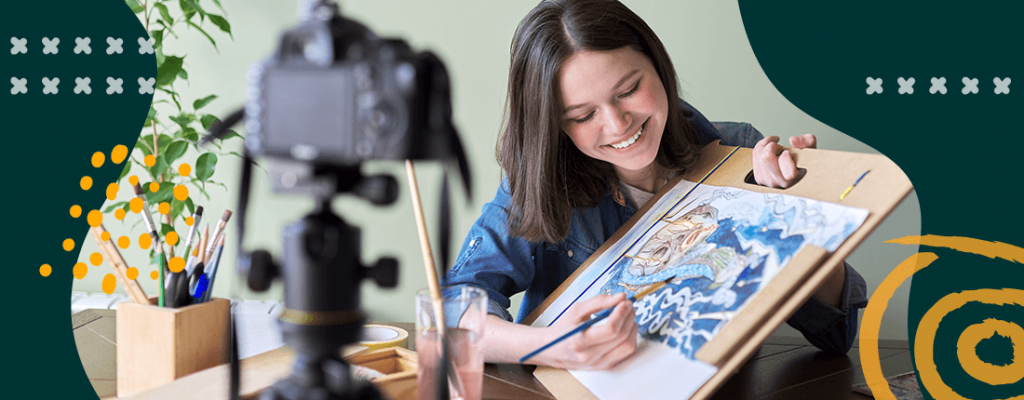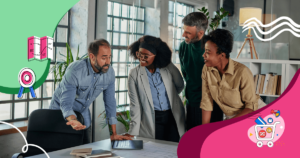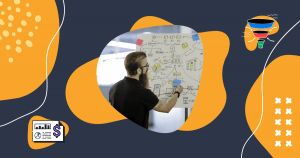Even with the vaccine, the decreasing statistics and the airs of optimism of a less restricted New Year, it is undeniable that the last two years have been challenging for many across the world.
Between isolated quarantine and the loss of loved ones, COVID-19 has changed the way of life as we know it — definitely in our personal lives, as well as professional ones.
With the pandemic, remote work became the only way for many to continue their daily work. In the beginning, we did it out of obligation. But not long after, we began to see the positive side of this new concept (not just for the employee, but for the company as well).
It was in the last two years that Rock Content definitively stabilized itself as a global remote-first company. (A desire that was already under construction and ended up being accelerated by this unfortunate world situation. We might say we made a sweet lemonade from a sour lemon.)
People from all over the world were able to work together in a single company. Physical location was no longer the main factor in hiring. We were able to focus on bringing talent to the team, no matter where in the world they are.
We are not alone, of course. Some companies have already announced a return to the office — but many of them are adopting some type of hybrid model that allows employees to work part-time in their homes and part-time in the office.
This scenario shows two sides of the same coin. On the one hand, this reality can be extremely positive and liberating. On the other hand, it is necessary to know how to deal with remote work and avoid common traps that, by now, you are probably familiar with: low productivity, difficulty to relax, feelings of isolation, among many others.
So, what do you do? How does one cope with chaos and tedium or find ways to be inspired artistically within this new reality that apparently is here to stay?
As creative souls ourselves, we have found a few ways to beat these tricky traps. Read on to learn our tips, and see if any of them inspire you to get creative — remote style.
#1. Put On Your Monday Clothes
There is nothing comfier than an oversized shirt and a loose pair of pajama bottoms. They are comfortable clothes, a hug for your body after a long day. If you have time off, they become your weekend loungewear and are a great escape from having to dress up for the social world.
The first few weeks of the pandemic were a delight. Every set of pajamas got a trial; we even ordered special silky ones to feel fancy while we lazed about. But two years later, our stiff professional clothes are eyeing us, wondering when we are coming back.
As delightful as loungewear is, accepting it as a long-term style can affect your creative self-esteem. A comfortable bed and comfortable clothes will make your body feel like it should be at rest — not at work. This makes feeling productive, producing content and getting your creative juices flowing more challenging than before.
The article Enclothed Cognition, published in the Journal of Experimental Social Psychology, details how wearing the right clothes affects some professionals.
This experiment found that doctors wearing their lab coats performed with greater stamina and attention to detail than those without. Additionally, when presented with two coats labeled “doctor’s” and “painter’s,” those wearing the doctor’s coat projected higher confidence and sustained attention than those with a painter’s coat.
This means that clothes can affect our daily productivity, not only in style but also in how we choose to label them. Your pajamas and loungewear are clothes to relax in, not to create in. So, if you want to get productive, choosing the right working outfit is essential, even at home.
Consider purchasing a new outfit for the task at hand. I recommend something easy to move in but more dressy than casual wear. Call it your power outfit, body armor or whatever title evokes a sense of fiery passion. Wear it when doing tasks from home. Put on the suit, and include a fancy watch if you want to. Then, when you clock out for the day, return to the sweet sweatpants you know and love.
Practice this every day to make it a routine habit. Keep your power outfit for power tasks, and avoid wearing it to bed or to socialize. With its purpose pure, you may find yourself professionally producing more than before.
#2. Daily Diary
It’s easy to lose a sense of time when you work from home. Days quickly blur together, and though it makes Mondays less woeful, it also makes Fridays less exciting. This is usually where the rut sets in, with little excitement or variance in your days to make them feel any different.
So how do you escape? We are still (gradually) returning to normal — if there is a normal at all. Even in an optimistic scenario, the feeling of caution in leisure events remains. When you can’t find excitement and diversity in your life from the outside, it’s time to take an introspective lens to the inside.
This is where journaling comes in. Keeping a daily devotional or dream diary is a great way of organizing your thoughts and reviewing your day. For creative minds, journaling is a vital log of ideas, inspiration and important notes that can help carry you through your next task.
Sadly, journaling can feel a bit awkward for adults in 2022. Many think journaling is exclusive to two categories of people: sad teens and famous public figures. You may think your life isn’t interesting enough to journal, or your ideas aren’t good enough to dictate. But I am here to remind you that isn’t true.
There are endless studies on the connection to mental well-being and a daily journal. The University of Rochester discusses how journaling not only helps with managing anxiety and coping with depression but aids in organizing thoughts and tracking the days. You gain the positive effects of journaling when remembering these two simple rules: you are writing for yourself and no one else, and there are no boundaries.
Start small. Find the coolest journal online with a pen that glides across the page, and write whatever comes to mind. This could be a funny joke, remembering a good meal you had or even a tiny doodle of something that inspires you. Write down a dream you had at night, or scribble down a quick, creative quote that ran through your mind. Start to expand, talk about things that bother you or something that frustrates you.
Make journaling a habit, and you will be amazed at what you can produce. The malaise of days becomes less overwhelming, and reading back on what you did in a day can help as a physical reminder of just how hard you work. The act of writing may even lead you to the solutions you were looking for.
If writing on a blank page seems too daunting, look into guided journaling. Guided journals have small tasks and prompts every day to encourage creative writing and mental wellness. I recommend Keri Smith’s Wreck This Journal, a guided diary that challenges you to destroy it with insane, creative prompts.
Daily journaling may not fix procrastination and other difficulties you might face when working from home, but it gives you a personal companion to walk with through these times. It may even act as a source of inspiration years down the line when you review the struggles of this trying time and wonder just how you made it.
#3. If At First You Don’t Succeed, Keep Trying
One of the most dangerous things you can do to your physical, professional and creative self is to let failure cripple you. Some of us are taught coping mechanisms for professional and academic failure in school and learn how to let failure guide us to do better than before — but creative failure? No one prepares you for that.
Think back to the early days of the pandemic, where everyone was picking up a new hobby to pass the time. Most dropped the task within a few weeks simply because their end product didn’t look good enough. The DIY looks great in the video, but it can be a real gut punch when the final product is lackluster.
Some were shamed for their new hobby. Social media loves to call out tasks as “basic” or “uncreative” simply because they are trending at the moment. (Looking at you, pumpkin spice lattes.) Eventually, the result was the same. Sourdough bread tossed in the trash, knitting needles collecting dust in the closet and a fresh set of paints left unopened.
In a sense, these dropped hobbies became a metaphor. You became so focused on what others thought about the final product that you lost the joy of the process. Opinions of strangers on the internet became more valuable than your thoughts, leaving you even more listless and isolated than before. If it wasn’t perfect the first time, then it’s just better to discard it as a whole.
When we work from home, we tend to look for references online. (Since we’re working alone this might be, most of the time, the only source of comparison and inspiration that we have.) But this doesn’t always yield realistic results. Failure and judgment halted your creative growth.
Break the cycle. Pick that hobby up again, or try something new! Enjoy the process instead of focusing on the outcome. Revel in the relaxation of painting a canvas, let your mind wander while you work on knitting one and curling two and enjoy licking the spoon clean of cake batter. Every art requires practice to master, but you have to learn how to enjoy the creative process long before making a perfect creation.
Look away from social media and the performative actions of your friends. Don’t feel the need to Instagram your first try or make it Photoshop perfect. Take it as it is: the first attempt. It may be sloppy and crude — but you made it. And with every additional creation, it will get better and better.
Incorporating this thought into daily hobbies and activities is the first step and then comes incorporating them into your professional activities. Reignite your passion for creating to create, not to produce a Mona Lisa. Remember, even the greatest artists weren’t recognized in their time for their masterpieces, so don’t rely too much on public opinion.
#4. TTYL Notifications
The most important tip for maintaining mental health and energy on remote work is the simplest of all. It’s about creating a space for yourself away from the rest of the world and your workload. Knowing when you need to work is important, but knowing when to unplug is vital.
It’s easy to get attached to the online world. Via phone or laptop, you are always connected. Even during hours when you aren’t working, you may feel pushed to answer an email, respond to a text or fix a problem. Being “on” all the time will drain you mentally and physically, making it harder to perform and harder to recharge.
Forbes put it expertly in their article ‘How To Disconnect From Work And Enjoy Your Downtime (Without Feeling Guilty).’ They explained how a consistent grind could cause guilt, extra stress and worsen your overall health by simply not taking a break. When was the last time you walked around or stretched? Did you even drink water today? Don’t push yourself for just one more email, and know when to step back and do something else.
Set a firm schedule for your work as you would an in-person office. Set the alarm for your end of the day as a reminder to put down the laptop and make time to enjoy yourself.
Unless you are paid overtime or an important project is due in 24 hours, it can wait until tomorrow. Put your phone on “Do Not Disturb,” and set an out-of-office email system, so your co-workers know they can’t ask you to work whenever.
Finally, when winding down for the day, silence your phone. Facebook, Gmail, Instagram and other media can suck you in with endless notifications that trigger an endless scroll. Take a break from your phone and let it charge in peace while you recharge in peace. Prioritize your well-being before productivity and before pleasing others.
Don’t forget yourself
Our tips and tricks aren’t a one-size-fits-all fix for life’s problems. As I said, there are many advantages to working in a remote-first company (advantages that would never be possible in any other reality). Hopefully, these tips can help to blunt the downside (and some situations that we’re — still — adapting to).
Things are getting better, but the pandemic is not over yet, and it’s still hard to overcome the struggle some days. I understand because I feel it, too. I am right there with you. At the end of the day, no amount of “life hacks” will solve all of our current problems.
So my final tip isn’t a craft or action, but a bit of wisdom I’ve picked up along the road.
Give yourself grace. Not every day will be ok, but not every day will be bad. Spend less time angry at yourself for things you can’t control, and be kind to yourself with what you can. The creative balance will come when you remind yourself what matters most: yourself.
So stay kind, stay safe, stay healthy and keep on creating. Embrace these new opportunities for a healthy and productive 2022 so you can reap the rewards and have fun along the way with this working format.







